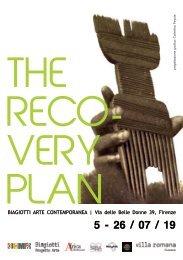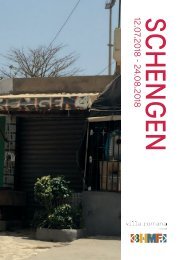Black Archive Alliance Catalogue
Create successful ePaper yourself
Turn your PDF publications into a flip-book with our unique Google optimized e-Paper software.
Sarah Parker Remond (1826-1894) graduated from the Santa Maria<br />
Nuova hospital school in 1868 with a diploma for professional<br />
medical practice. She was originally from Salem, Massachusetts,<br />
where she was born into a family of free African Americans.<br />
Her father, John Remond, was a famous local caterer and her<br />
mother, Nancy Lenox, was a fancy-cake maker. Her sisters<br />
ran hairdressing salons, manufactured wigs, and prepared a<br />
medicated lotion against hair loss. The entire family was<br />
active in campaigning against slavery, and Remond’s brother,<br />
Charles Lenox, was a well-known abolitionist lecturer who<br />
<br />
<br />
became a speaker for the American Anti-Slavery Society. Between<br />
1856 and 1858, she toured with other white and black activists,<br />
including her brother as well as Susan B. Anthony and Abbey<br />
Kelley, who were also campaigning for women’s emancipation.<br />
They spoke in New York City, Rochester, Utica, and Montreal,<br />
and in New England, Michigan, and Ohio. As Sarah Remond<br />
observed, the audience at their antislavery lectures was<br />
“closely packed.”1<br />
<br />
continued to speak against slavery, at times lecturing together<br />
<br />
received and newspapers praised her as “one of the best female<br />
<br />
with Clementia Taylor and her husband, Peter Taylor, member<br />
of Parliament. Their home, the Aubrey House, was one of the<br />
central gathering places of London radical reformist circles.<br />
Sarah Remond became a member in the London Emancipation<br />
Committee and in the executive committee of the Ladies’ London<br />
Emancipation Society established in 1863. She also enrolled<br />
at the Bedford Ladies College, where she studied such topics<br />
<br />
and became friends with Giuseppe Mazzini. She participated<br />
<br />
<br />
carried letters of introduction written by Mazzini.<br />
Sarah Remond arrived at ‘Firenze La Bella’ in August 1866.<br />
<br />
respectable pension, and signed up for a one-month membership<br />
at the Gabinetto Vieusseux newsroom and lending library. She<br />
wrote that she was not “here [in Florence] for pleasure, but<br />
for study.”3 Her request to be admitted to the Santa Maria<br />
Nuova hospital school, dated 30 October 1866, was written<br />
<br />
request reveal that in London she had studied medicine in the<br />
departments of midwifery and surgery at London University<br />
College, graduating as a nurse.<br />
The name of “Sarah Parker Remond, negra d’America” appears<br />
among the students admitted to the Department of Obstetrics<br />
at the Santa Maria Nuova hospital for the academic year 1866-<br />
<br />
took the entrance examination that permitted her to continue<br />
her studies. She passed the test with excellent marks<br />
(“benissimo”). The formal request letter in which Sarah Remond<br />
requested to be admitted to the school was dated 13 November<br />
1867; in the letter she gave her address as 8 Via Santo<br />
Spirito.<br />
<br />
her name to ‘Sara’: on 2 July 1868 “Remond Sara di America<br />
(Stati Uniti)” had completed her studies as well as practical<br />
<br />
The hospital school documents testify that on 29 July 1868,<br />
<br />
Uniti” had been given a permission to take the test, which<br />
<br />
a regular course of study and also of hospital practice, she<br />
[Sarah Remond] has recently passed the necessary examination,<br />
and received a diploma for professional medical practice.” Her<br />
<br />
newspaper, the Revolution: “Miss Remond is said to be not only<br />
well received everywhere in Florence, but she has friends among<br />
the very best people there.”4 She knew the poet Francesco<br />
dall’Ongaro, the Greek author Margherita Mignaty who held a<br />
salon on Via Cavour, and American art collector James Jackson<br />
Jarves, among many other prominent people visiting or residing<br />
<br />
<br />
“Sara P. Remond” was a housewife (“atta a casa”). She seems to<br />
have stayed married to Pintor until her death.<br />
Sarah Parker Remond is buried at the Non-Catholic Cemetery for<br />
<br />
passed away on 13 December 1894. Her residence at the time of<br />
her death was Florence and her profession, according to the<br />
<br />
Source: Salenius, Sirpa. An Abolitionist Abroad: Sarah<br />
Parker Remond in Cosmopolitan Europe. Amherst: University of<br />
Massachusetts Press, 2016.<br />
Sarah Parker Remond (1826-1894) si è diplomata presso la scuola<br />
ospedaliera di Santa Maria Nuova nel 1868 con un diploma di<br />
pratica medica professionale. Era originaria di Salem, nel<br />
Massachusetts, dove era nata in una famiglia di afroamericani<br />
liberi. Suo padre, John Remond, era un famoso ristoratore<br />
locale e sua madre, Nancy Lenox, era una pasticcera. Le sue<br />
sorelle gestivano saloni di parrucchiere, producevano parrucche<br />
e preparavano lozioni medicamentose contro la caduta dei<br />
capelli. Tutta la famiglia era attiva nella campagna contro<br />
la schiavitù, e il fratello di Remond, Charles Lenox, era un<br />
noto conferenziere abolizionista che fu tra i primi a parlare<br />
<br />
della schiavitù. Nel 1856, Sarah Remond divenne ambasciatrice<br />
per la American Anti-Slavery Society. Tra il 1856 e il 1858,<br />
insieme ad altri attivisti bianchi e neri tra cui suo fratello,<br />
Susan B. Anthony e Abbey Kelley, ha parlato a New York City,<br />
Rochester, Utica e Montreal, e in New England, Michigan e<br />
Ohio. Si battevano contro la schiavitù e per l’emancipazione<br />
femminile e, come ha osservato Sarah Remond, il pubblico alle<br />
loro conferenze antischiavitù era “estremamente affollato”.<br />
<br />
dove ha continuato a lottare contro la schiavitù, a volte<br />
tenendo conferenze con personaggi di spicco come Frederick<br />
Douglass. È stata ben accolta e i giornali l’hanno elogiata<br />
come “una delle migliori conferenziere” che avevano sentito. A<br />
Londra, è diventata amica di Clementia Taylor e di suo marito,<br />
Peter Taylor, membro del Parlamento. La loro casa, la Aubrey<br />
House, era uno dei luoghi centrali di ritrovo dei circoli<br />
riformisti radicali di Londra. Sarah Remond è diventata membro<br />
del London Emancipation Committee e del comitato esecutivo<br />
della Ladies ‘London Emancipation Society fondata nel 1863. Si<br />
è iscritta anche al Bedford Ladies College, dove ha studiato<br />
materie come il francese e il latino. A Londra, ha conosciuto<br />
Giuseppe Garibaldi ed è diventata amica di Giuseppe Mazzini.<br />
Ha partecipato a eventi di raccolta fondi per sostenere<br />
<br />
Quando si è trasferita a Firenze, portava con sé lettere di<br />
presentazione scritte da Mazzini.<br />
Sarah Remond è arrivata a Firenze “la Bella” nell’agosto del<br />
<br />
rispetto e si è iscritta per un mese alla redazione del<br />
Gabinetto Vieusseux e alla sua biblioteca. Ha scritto che<br />
non era “qui [a Firenze] per diletto, ma per studio”. La sua<br />
richiesta di essere ammessa alla scuola ospedaliera di Santa<br />
Maria Nuova, datata 30 ottobre 1866, era scritta in italiano.<br />
Le due lettere di referenza che accompagnano la sua richiesta<br />
rivelano che a Londra aveva studiato medicina nei dipartimenti<br />
di ostetricia e chirurgia presso il London University College,<br />
diplomandosi come infermiera.<br />
<br />
gli studenti ammessi al Dipartimento di Ostetricia all’ospedale<br />
<br />
anno ha assistito come uditrice alle lezioni, dopodiché<br />
ha sostenuto l’esame di ammissione che le ha permesso di<br />
continuare i suoi studi. Ha superato il test con ottimi voti<br />
(“benissimo”). La lettera di richiesta formale in cui Sarah<br />
Remond aveva chiesto di essere ammessa alla scuola è datata 13<br />
novembre 1867; nella lettera il suo indirizzo risulta essere<br />
Via Santo Spirito n.8..<br />
<br />
italianizzato il suo nome in “Sara”: il 2 luglio 1868 “Remond<br />
Sara di America (Stati Uniti)” aveva completato i suoi studi e<br />
il lavoro pratico e aveva chiesto di essere ammessa all’esame<br />
<br />
<br />
Salem Stati Uniti” aveva avuto il permesso di fare il test, che<br />
lei ha passato. Un articolo di un giornale americano conferma<br />
che “Dopo un regolare corso di studi e anche di pratica<br />
ospedaliera, lei [Sarah Remond] ha recentemente superato<br />
l’esame necessario e ha conseguito un diploma per la pratica<br />
medica professionale.” Le sue prospettive a Firenze erano<br />
buone, come testimonia un giornale americano, la Rivoluzione:<br />
“Miss Remond si dice che non solo è ben accolta ovunque a<br />
Firenze, ma ha amici tra i migliori.” Conosceva il poeta<br />
Francesco dall’Ongaro, l’autrice greca Margherita Mignaty che<br />
ha tenuto un salotto in via Cavour, e il collezionista d’arte<br />
americano James Jackson Jarves, tra molti altri personaggi<br />
importanti in visita o residenti a Firenze. A Firenze ha<br />
sposato un italiano sardo, Lazzaro Pintor, nel 1877. Secondo il<br />
<br />
<br />
alla morte.<br />
Sarah Parker Remond è sepolta nel cimitero non cattolico per<br />
<br />
il 13 dicembre 1894. La sua residenza al momento della sua<br />
<br />
di morte, era chirurgo (“chirurgo”).<br />
Fonte:Salenius, Sirpa. Abolizionista all’estero: Sarah Parker<br />
Remond nell’Europa cosmopolita. Amherst: University of<br />
Massachusetts Press, 2016

















